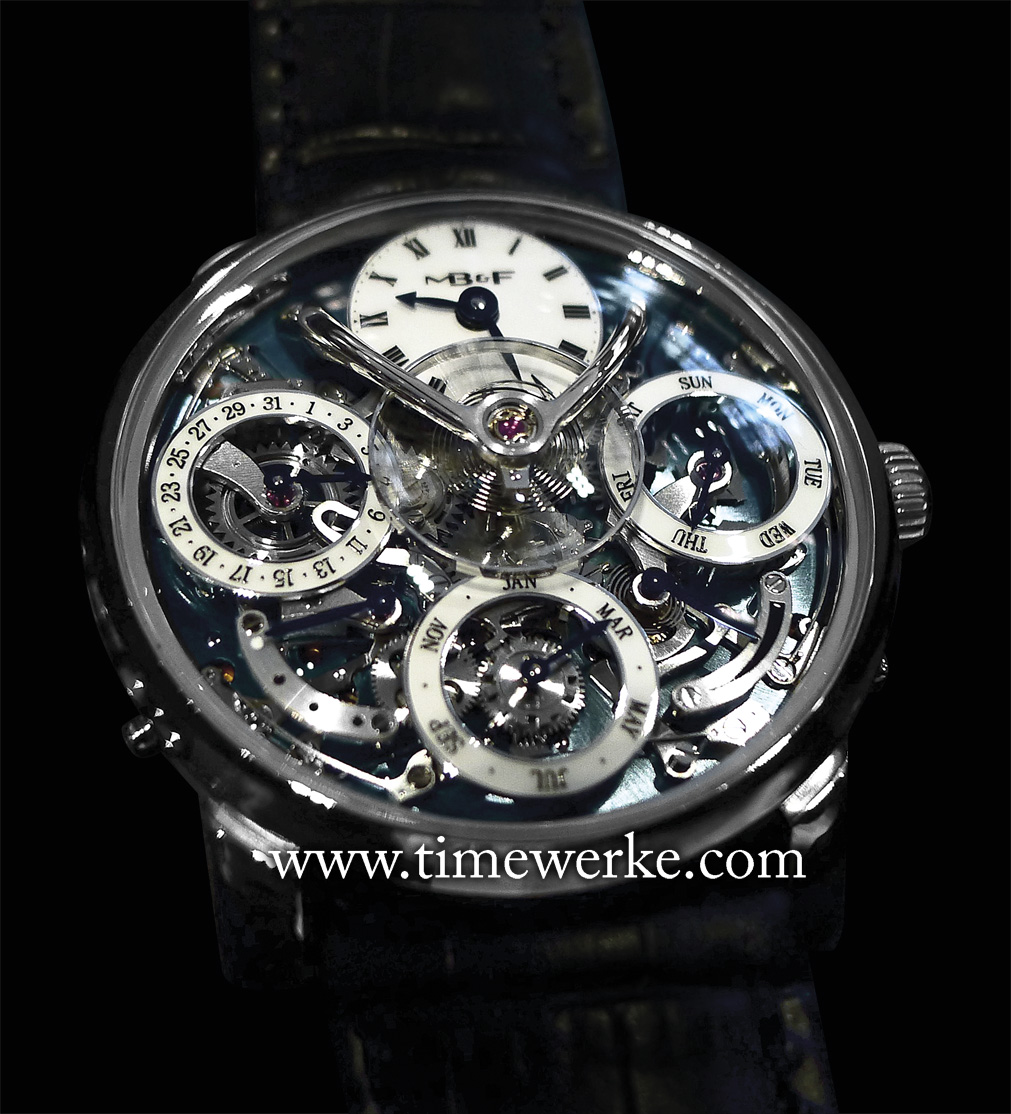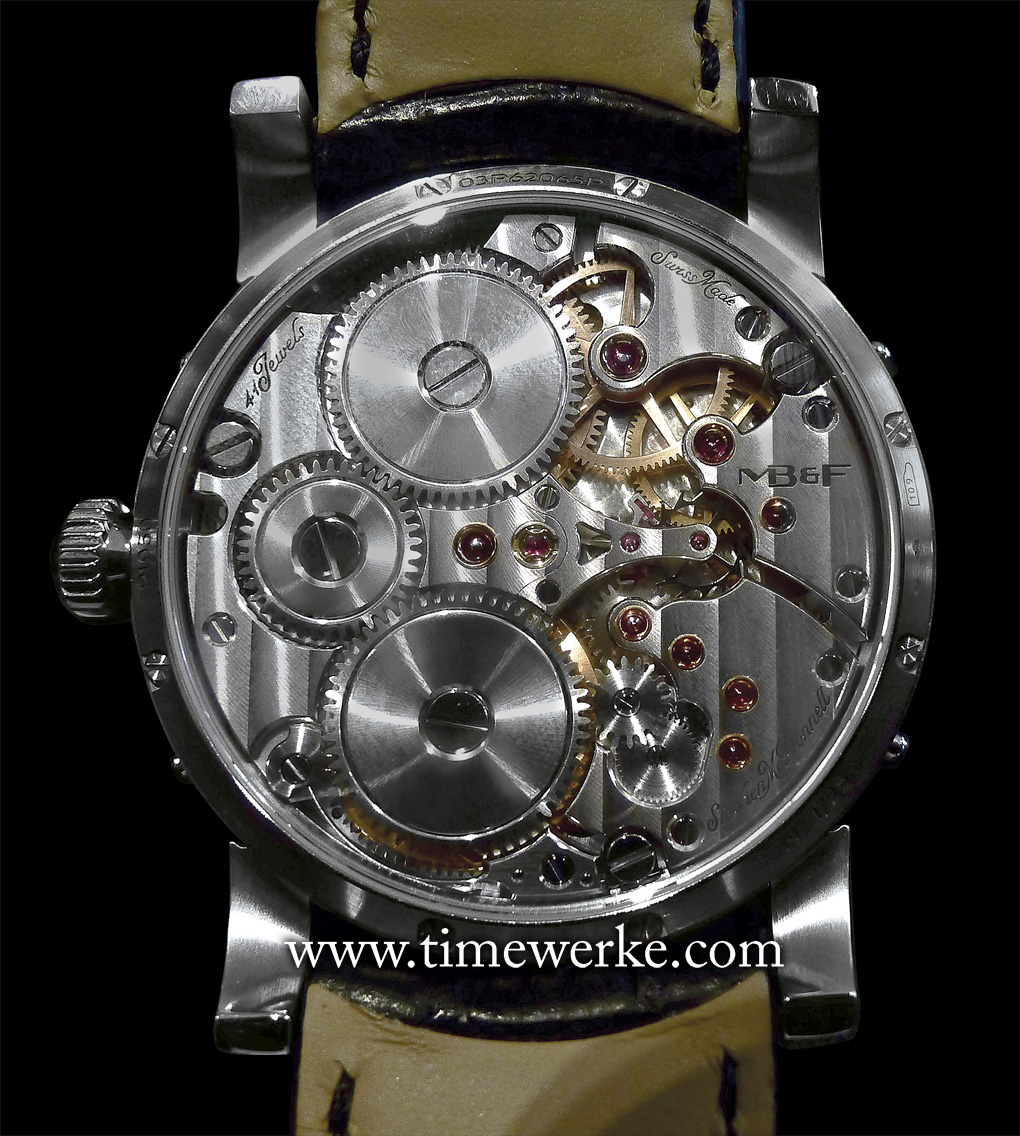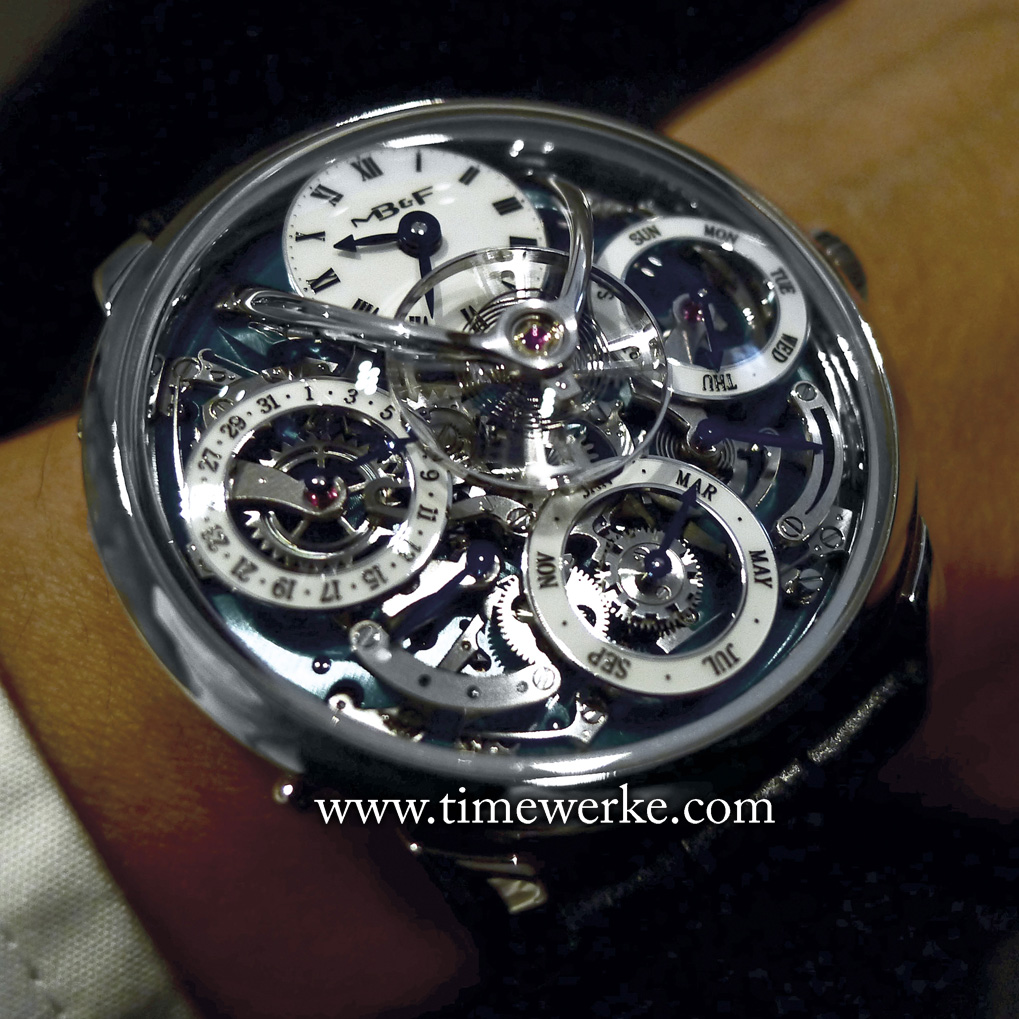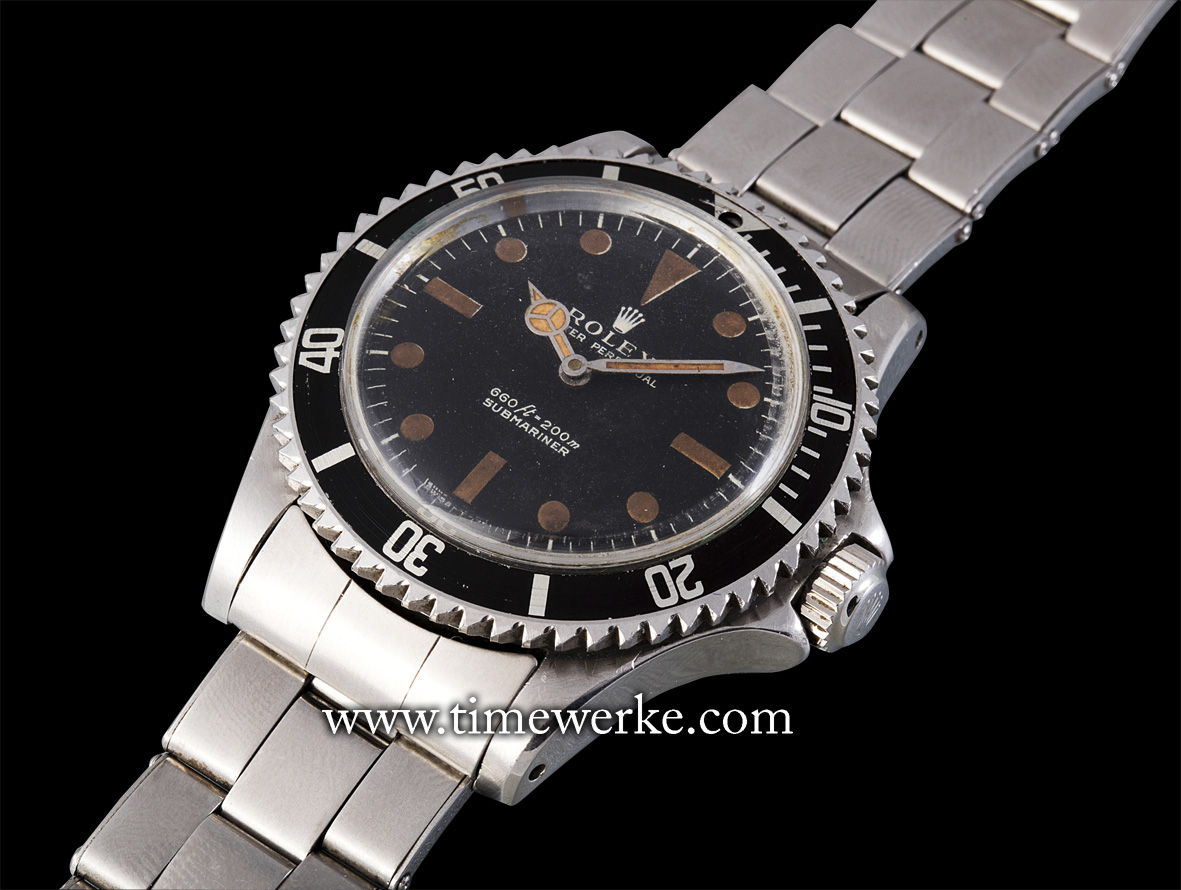
MB&F Legacy Machine Perpetual. Introduced in 2015. This perpetual calendar, housed in a 44mm diameter case with a height of 17.5mm, features the hour and minutes on the sub-dial at 12 o’clock, the day at 3 o’clock, the month at 6 o’clock and the date at 9 o’clock. The power reserve display is between 4 and 5 o’clock and the leap year indication is between 7 and 8 o’clock. Limited to 25 pieces in 18K 5N red gold (priced at SGD226,000) and 25 pieces in platinum 950 (priced at SGD275,100). Shown above is the Legacy Machine Perpetual in platinum. Photo: © TANG Portfolio
Launched on 3 November 2015, MB&F’s Legacy Machine (LM) Perpetual is a true technical beauty. As there isn’t any dial, the “machine”, otherwise known as the calibre is exposed and is for all to see in its true glory.
Ask MB&F founder and owner Maximilian Büsser how long it took to develop the movement and his official stand will be four years. Probe a little deeper and the “unofficial” answer will be more like nine years.
“The Legacy Machine Perpetual is the fourth in the LM series. It took us four years to create but it is actually nine years old,” Büsser discloses. This means the LM Machine Perpetual story dates back to the year 2007.
That was the year MB&F was close to bankruptcy, says Büsser as the supply of components for the movement of the brand’s first wristwatch – the HM1, suddenly ceased.
In January 2007, Peter Speake-Marin, a good friend Büsser and an independent watchmaker who was aware of the dire situation, called in favours from his friends.
“We only had five movement kits [of the HM1]. Peter finally gathered some of his watchmaker friends. Apart from Laurent Besse, there were four watchmakers and I had never heard of any of their names before. We had no assembly plans but told them to try assembling the movement.
“It was a trying process. I was ‘dissolving’ as time went by, especially between January to May 2007. I knew I’d be bankrupt in June 2007 as my money including the one million Singapore dollars advance given would be gone. Thankfully, by June 2007, we managed to deliver the first two pieces [of HM1],” says Büsser.
He managed to stave off bankruptcy in the nick of time. “Among those five watchmakers, one in particular stood out – Stephen McDonnell. He was from WOSTEP (Watchmakers of Switzerland Training and Educational Program) and he took the lead. It was Stephen who re-touched the parts in his workshop at home,” reveals Büsser, and the rest, as they typically say, is history. The HM1 was launched in 2007.
Some four years later (in around 2011), Peter Speake-Marin approached Büsser in Basel and informed him that McDonnell was in a “hot spot”.
“Stephen had quit his job as a professor and began developing movements for a brand that could no longer pay him. I had a word with Stephen and he told me that he had found a solution to the perpetual calendar problem.
“Stephen said that how the perpetual calendar mechanism is done is wrong. He told us that the whole principle did not make sense. What is typically done is to add a module onto a base movement that forces the date disc to jump when it doesn’t want to.”
A perpetual calendar watch is one that is equipped with a device that changes the date at the end of each month, including the 29th of February during leap years, states The Illustrated Professional Dictionary of Horology I + II by G.-A. Berner. The watch can also indicate the leap years.
The number of days in a month varies, either with 30 or 31 days with February having 28 days during non-leap years and 29 days in a leap year. As such, the mechanism in a typical perpetual calendar module will “force” the date to “jump” from “30” to “1” or “28” to “1” during non-leap years and “28” to “1” during leap years.
“Traditional perpetual calendar mechanisms use the grand levier system and a 31-day month as the default and basically ‘delete’ superfluous dates for the months with fewer days – by fast-forwarding through the redundant dates during changeover. A traditional perpetual calendar changing from 28 February to 1 March scrolls quickly through the 29th, 30th and 31th to arrive at the 1st.
“Stephen told us that the movement should ideally go to 28 days every month and it is to build upon it. Based on this in addition to the fact that Stephen had saved us [in 2007], we said ok,” says Büsser.

The Calibre with the fully-integrated perpetual calendar system was developed for MB&F by Stephen McDonnell. This manual-winding movement comprises 581 components and has 72 hours of power reserve once fully wound. It is water-resistant to 30m (90 feet). Photo © TANG Portfolio. Elfa / Timmy 2015.
What McDonnell did was to use a “mechanical processor” rather than the conventional space-consuming grand levier (big lever) system architecture. “The MB&F mechanical processor utilises a 28-day month and adds extra days as required.
“This means that each month always has the exact number of days required; there is no fast-forwarding or skipping redundant days. And while the leap year can only be set on traditional perpetual calendars by scrolling through up to 47 months, LM Perpetual has a dedicated quickset pusher to adjust the year.”
The Calibre developed by McDonnell is a fully-integrated movement incorporating the perpetual calendar feature. There is no perpetual calendar module.
As such, by doing away or rather, not using the grand levier, the perpetual calendar mechanism of the LM Perpetual can be placed on top of the movement mainplate to be seen and appreciated on the dial side.
The “mechanical processor”, with a patent pending (MB&F patent but in McDonnell’s name) comprises a series of superimposed discs. As all months have at least 28 days, this is the logical default number and the extra days are added as required by each individual month.
With exactly the right number of days, there will be no “skipping over” redundant days and therefore no possibility of the date jumping incorrectly. This is therefore a safety feature.

Stephen McDonnell has put in place a totally new perpetual calendar system into MB&F’s Legacy Machine Perpetual. Born in Belfast, Northern Ireland in 1972, McDonnell took an early interest in watchmaking. He was formerly a senior instructor at WOSTEP (Watchmakers of Switzerland Training and Educational Program) and has worked for brands (and well-known watch industry veterans) such as Christophe Claret, Maître du Temps, MB&F and Peter Speake-Marin. McDonnell is currently working for British watch brand, Bremont. Photo © MB&F
There is another inbuilt safety feature; the quickset pushers found on the sides of the case of the LM Perpetual disconnect during the date changeover to prevent any risk of damage by the owner.
What is most striking about the LM Perpetual is the suspended balance wheel at the centre of the dial. It is also intriguing to note that the escapement is not found on the front; rather, it is placed at the rear of the movement.
This suspended pulsating balance wheel on the dial side is perhaps the main attraction for genuine connoisseurs. Having the balance wheel on the front and the escapement anchor at the back is a world premiere, highlights Büsser.
To connect the balance and the escapement, perhaps the world’s longest balance wheel pinion had to be made. This balance staff measures 11.8mm in length.
The development of the LM Perpetual took three-and-a-half years to complete. “Stephen’s perpetual calendar is the most extraordinary movement I have ever seen. This is his first-ever movement and his legacy starts here.

The MB&F Legacy Machine Perpetual. The suspended balance at the centre of the dial is the main attraction. The platinum version seen above is limited to 25 pieces and is priced at SGD275,100. Stephen McDonnell’s legacy begins with the Legacy Machine Perpetual. Photo © TANG Portfolio
“Stephen is a real sort of genius. I am sure watch collectors will be hearing a lot about him in the years to come,” says Büsser.
[Editor’s note: Stephen McDonnell is now working for British watch brand, Bremont.]
Indeed, the Legacy Machine Perpetual is very apt for McDonnell as this will most likely be the machine that seals his name in horological history for perpetuity given its innovativeness and fresh concept in tackling the perpetual calendar mechanism.

